
 |
|
|
#1 |
|
All the news that's fit to excerpt
Name: newsie
Location: who knows?
Join Date: Jun 2008 Motorcycle(s): only digital replicas Posts: Too much.
|
[motorcycle.com] - 2014 Super Naked Street Brawl + Video
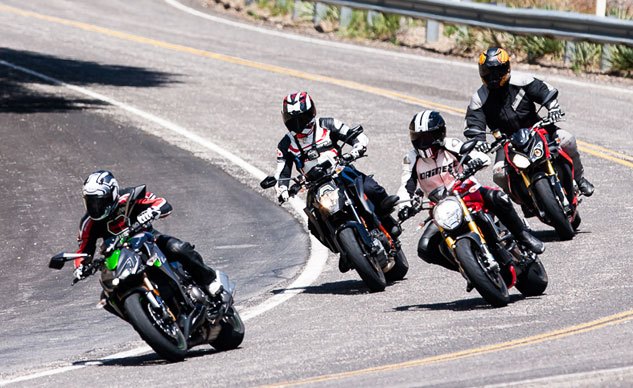  In the track version of our Super Streetfighter Smackdown, the KTM 1290 Super Duke R won over the BMW S1000R by the narrowest of margins. Which is all well and good for the small percentage of riders who’ll actually take these bikes to the track. For the greater population, riding these motorcycles on the mean streets of America, the streetable personas of these two and the Ducati Monster 1200S and Kawasaki Z1000 ABS are far more important. Similar to the track shootout, scoring these four (the MV Agusta was unavailable for street testing, but you can read about it here: 2013 MV Agusta Brutale 1090 RR Review – Quick Ride) was extremely close, with the two finalists separated by only 1.07% or 5.75 points (497.75 vs 492). Video Keeping with the same fashion of the first story, each editor will present the pros and cons of an individual bike, beginning with our Chief Wheelie Editor, Kevin Duke. BMW S1000R 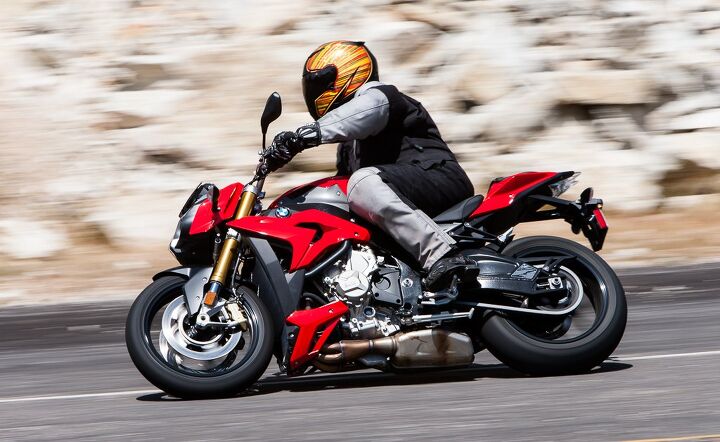 The BMW has rock-solid laser-beam steering, and with its TC, you can just fire and forget and not worry about bumps or slick patches or much of anything. The BMW has rock-solid laser-beam steering, and with its TC, you can just fire and forget and not worry about bumps or slick patches or much of anything.BMW has been on a roll lately, debuting new models that usually end up at the top of their classes. The S1000R continues that hot streak, bringing to the naked sportbike market one of the hottest and most capable streetfighters ever. It’s essentially a riff on the all-conquering S1000RR, and it’s a better streetbike in every possible way. Ergos are much more suitable for street use, with a handlebar set at a sporting but comfortable reach and a plusher seat with plenty of fore/aft room to vary the riding position if desired. Taller riders, however, wished for more legroom; BMW missed an opportunity to fit adjustable footpegs. 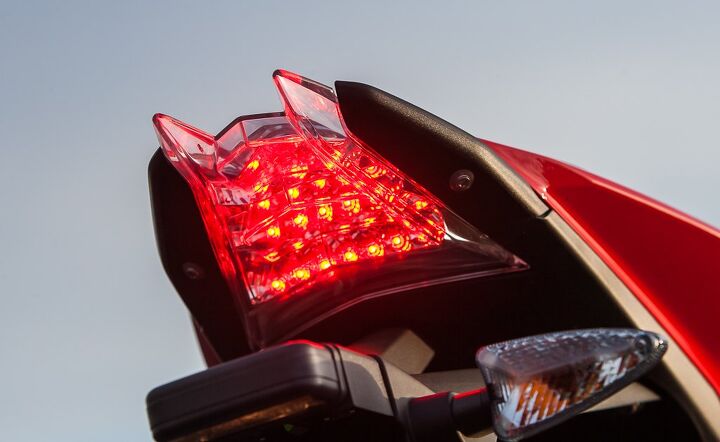 The BMW’s clear-lens LED tail lamp is one of our favorite styling elements of the S1000R. The BMW’s clear-lens LED tail lamp is one of our favorite styling elements of the S1000R.Of all the bikes in this test, the S1000R requires the least amount of time to feel comfortable. Everything works as you’d hope it would, feeling entirely natural and predictable from mile 1. “The S1000R really impresses with its relative ease of pace,” Ginger Director, Sean Alexander notes. “It feels like nothing so much as a Japanese supersport, which is truly a blessing and a curse.” The 1000R’s most obvious advantage is its hummingbird-like agility, bending into corners with just a light touch on the bars. It feels many dozens of pounds lighter than the Monster or the Zee. “When in motion, the S1000R feels much lighter than its actual curb weight,” Content Editor, Tom Roderick opines. “Its nimbleness and agility on tight, twisty roads is without equal among these four fighters.” No need to worry about the R’s retuned inline-Four engine feeling anemic. Although it is down a claimed 33 hp from the RR’s incredible 193 horses, it belted out 155 ponies to the rear wheel, less than a horse shy of the KTM’s dominating Twin that enjoys a 300cc advantage. For those keeping count, that’s more power than a Yamaha R1. 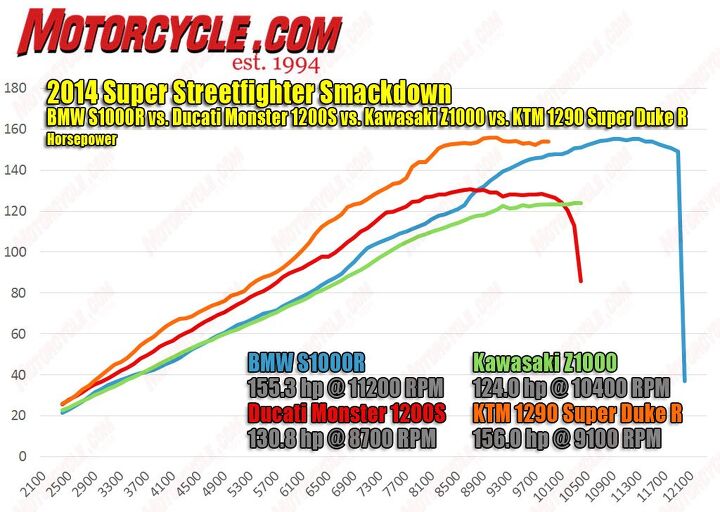 Not much separates peak horsepower figures of the BMW and KTM, but the Super Duke makes more power than anything else in this shootout at all engine speeds until it hits its rev limiter. You can also clearly see the Ducati makes more HP than the BMW where it counts on the street; in the mid-range. Not much separates peak horsepower figures of the BMW and KTM, but the Super Duke makes more power than anything else in this shootout at all engine speeds until it hits its rev limiter. You can also clearly see the Ducati makes more HP than the BMW where it counts on the street; in the mid-range.Redesigned cylinder head ducts and new cam profiles give the 1000R a bigger midrange punch than the RR, and a rev ceiling clipped by 2000 rpm allowed the use of steel valves rather than lightweight titanium poppets. But make no mistake; this is a seriously powerful motor that has more steam than almost anything under a liter of displacement. Other changes from RR to R include: A rake stretched by 0.8 degree to 24.6 degrees; an additional 5mm of trail to 98.5mm; and a reworked swingarm that stretches wheelbase nearly an inch to 56.7 inches. It also boasts a slightly larger pillion pad than the RR, but it’s too thinly padded for anything resembling comfort. All these things are true for the base model 1000R, which retails at $13,150 if you can find one. It includes two ride modes (Rain, Road) and ASC, BMW’s lower-end traction-control system that doesn’t use a lean-angle sensor. For an extra $845, the so-called Standard package is a nice deal, as it includes up-spec traction control (DTC), the addition of Dynamic and Dynamic Pro riding modes, a quickshifter and cruise control. 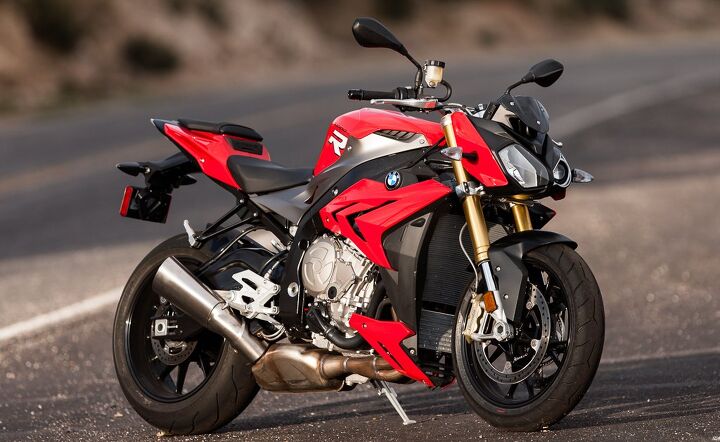 If you see gold-anodized fork on an S1000R, it has DDC. If you see gold-anodized fork on an S1000R, it has DDC.But it’s the top-line Premium package ($14,950), like our test unit,*that’s most desirable. it includes all the stuff listed above and adds heated grips, a chin spoiler and Dynamic Damping Control, a semi-active suspension system. DDC adapts automatically to speeds and riding conditions, and is fine-tunable at the touch of a button – it’s like magic for a suspension. In its Dynamic mode, the damping firms up over the Road setting, while Dynamic Pro offers tauter damping, disables the rear ABS and allows wheelies while still retaining traction control. These electronic systems might frighten luddites, but they’re all useful and surprisingly easy to navigate. “Within minutes and without instruction,” observes Roderick, “I was able to adjust the shift light from its 7k-rpm setting to 10,500 rpm – a process on other bikes that requires reading the owners manual.” The instrument panel offers oodles of info, including the S1000R’s track mode that displays details of the current, best or last lap time. It can even drill down to display the time per lap the brakes were applied, the throttle position in percentage per lap and the number of gear shifts per lap. 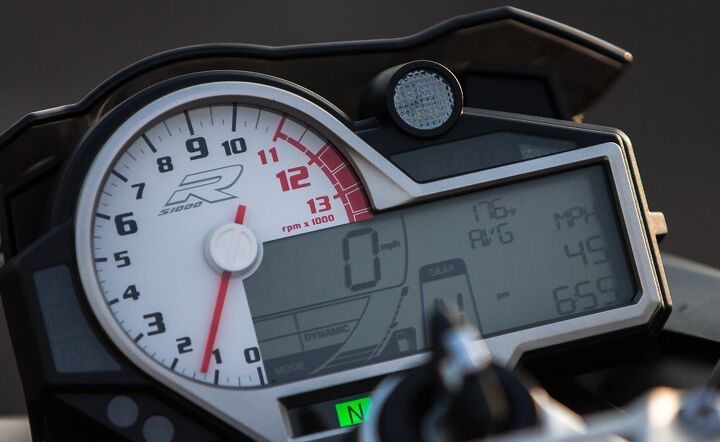 BMW won the Instrument/Controls section not only because of its easy-to-read gauge cluster, but also for its ease of operation and adjustment. We appreciate the separate buttons for heated grips and suspension modes, instead of making you scroll through a menu. BMW won the Instrument/Controls section not only because of its easy-to-read gauge cluster, but also for its ease of operation and adjustment. We appreciate the separate buttons for heated grips and suspension modes, instead of making you scroll through a menu.The 1000R is so well-engineered that it was surprising to find flaws, but they are there. Maneuvers in tight spaces are impeded by what is easily the most limited steering sweep of this group. Initial bite from the front brakes can be abrupt if not given extra care. Also, the engine’s lack of a counterbalancer allows more vibrations to make their way to a rider. They’re tolerable below 75 mph but become burdensome at higher speeds, a chore that’s only somewhat ameliorated by BMW’s cruise control. The final area that received scrutiny by some editors is the S1000R’s lack of a distinctive character, mostly due to the ubiquitousness of its inline-Four powerplant. “This BMW packs a ton of value into a technologically advanced and thoroughly engineered package that gets the job done with a minimum of drama,” Alexander says. “Perhaps too little drama, if you ask me.” 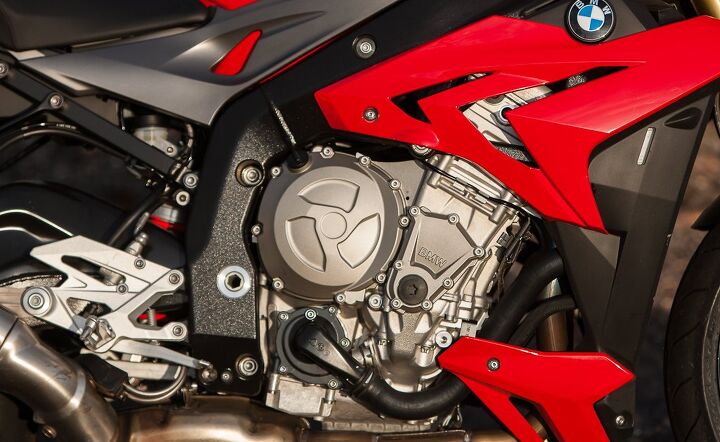 The $15k BMW comes equipped with a quick-shifter, semi-active suspension and cruise control, technologies the more expensive SDR doesn’t offer. The $15k BMW comes equipped with a quick-shifter, semi-active suspension and cruise control, technologies the more expensive SDR doesn’t offer.The S1000R is a scintillating sports roadster, there is no doubt. And the word value can actually apply to this Beemer – the base model is only $1,150 more than the Z1000, and the loaded version is $2k cheaper than the Super Duke R despite having active suspension, cruise control and a quickshifter, items not available on the KTM. We love it. And we bet BMW wishes its Austrian rivals hadn’t introduced the SDR. –Kevin Duke Ducati Monster 1200S 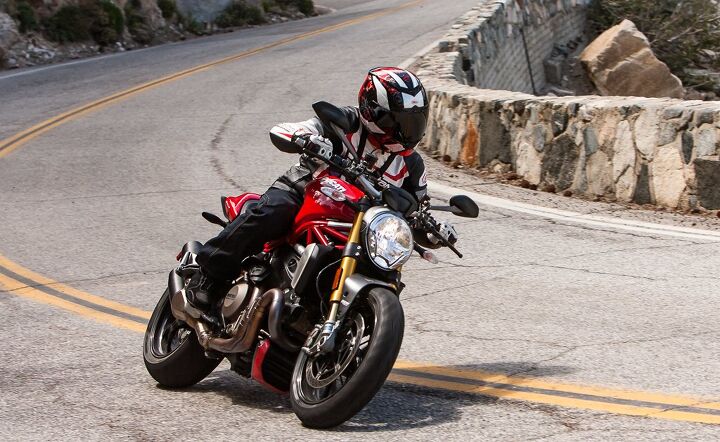 The Monster doesn’t quite reach the heights of aggression of the true streetfighters in this group. That role should be filled by a new big-inch Streetfighter, which will hopefully debut next fall with a hot-rodded version of the Monster’s mill. The Monster doesn’t quite reach the heights of aggression of the true streetfighters in this group. That role should be filled by a new big-inch Streetfighter, which will hopefully debut next fall with a hot-rodded version of the Monster’s mill.Everything the Ducati Monster 1200S gave up in terms of competitive track performance it gained back in the street-legal environment for which it was created. This should come as no surprise. The S1000R is derived from its all-conquering S1000RR, and KTM extolled the Super Duke R’s track pedigree by hosting its press launch at the Ascari Circuit in Spain. The Monster 1200S and Kawasaki Z1000 ABS, on the other hand, don’t claim the same racetrack DNA instilled in BMW and KTM. So, chastising the Duc and Kawi for not being as track-proficient as the other two is akin to berating something with gills for its inability to breath on dry land. To my eyes the new Monster is hands-down the sexiest two-wheeler of this quartet, and sex appeal when profiling on the street is important. To score the Ducati last in both the Cool Factor and Appearance categories of the ScoreCard, Neckerchief Editor, John Burns, must have been wearing his wine bottle goggles. Everyone has a bad side, and while the left profile of the Monster is certainly lacking, from every other angle the bike is simply mouth-watering. “The Monster’s fat python exhaust headers and stout red trellis frame are very appealing, all those cooling and vent hoses … not so much,” said Alexander in the track portion of this two-part test. 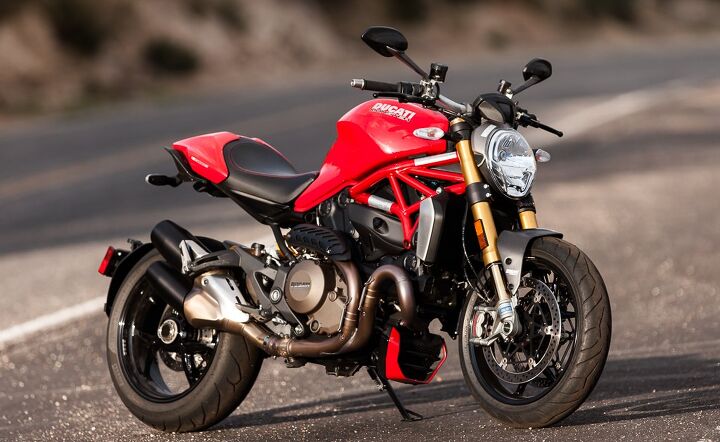 If beauty is in the eye of the beholder, John Burns might be blind. If beauty is in the eye of the beholder, John Burns might be blind.Complaints of the bike’s limited cornering clearance and combination of awkwardly uncomfortable footpegs/passenger peg brackets faded from memory when operating the Duc at the lower aggression levels used on the street. “Compared to the others, a rider sits further inside the cockpit on the Monster,” says Duke. “The ergonomic compromises of footroom noted on the racetrack were mostly forgotten on the street, and dragging pegs were a non-issue.” The strength of the Ducati package, though, is its torquier-than-thou liquid-cooled, 1198cc Testastretta 11° V-Twin engine. With enough real-world, usable mid-range power to outgun the others in top gear roll-on contests and blast out of tight corners with unmatched ferocity, the Monster lives up to its namesake. 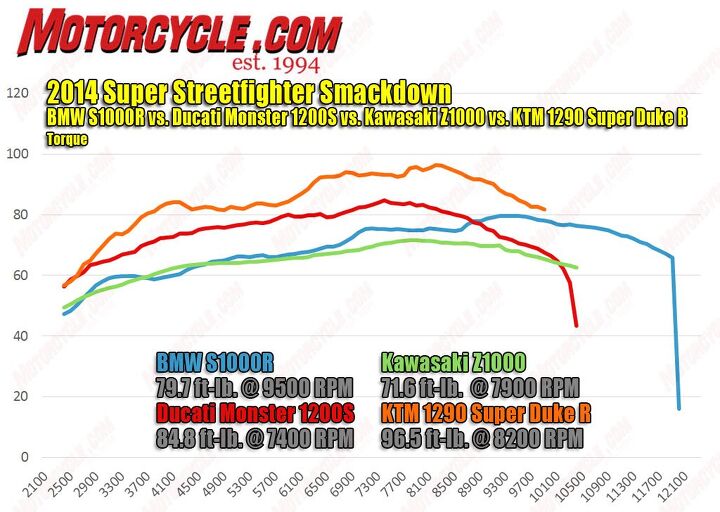 There’s no denying the KTM is the real monster when it comes to torque production, but the Duc’s 90° Twin produces a flatter, smoother flow of foot-pounds than the KTM’s 75° Twin. There’s no denying the KTM is the real monster when it comes to torque production, but the Duc’s 90° Twin produces a flatter, smoother flow of foot-pounds than the KTM’s 75° Twin.“The Diavel-derived 90-degree V-Twin in the new Monster 1200S continues to impress on the street,” says Alexander. “I was surfing its wave of midrange torque on the road because top-end performance remains a moot point 98% of the time.” Announcing the Ducati’s arrival is a thunderous baritone emanating from its twin-stacked mufflers. Whether bouncing off skyscrapers or canyon walls, the Monster heralds its arrival with auditory authority. 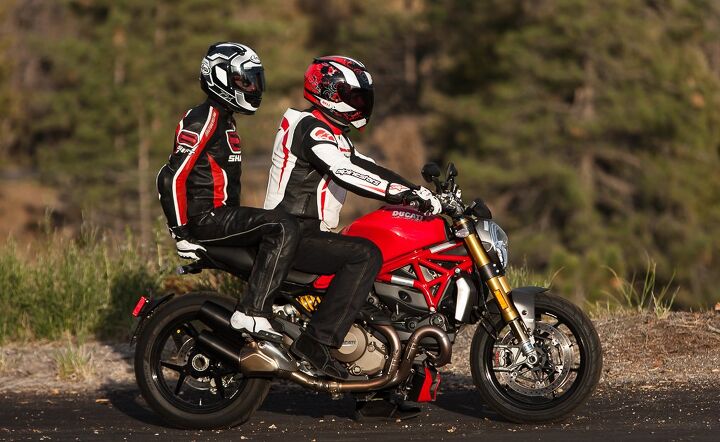 “The Monster has the only pillion on which you’d want to place someone you really love,” says Duke. Roderick to Duke; “I love you, man.” “The Monster has the only pillion on which you’d want to place someone you really love,” says Duke. Roderick to Duke; “I love you, man.”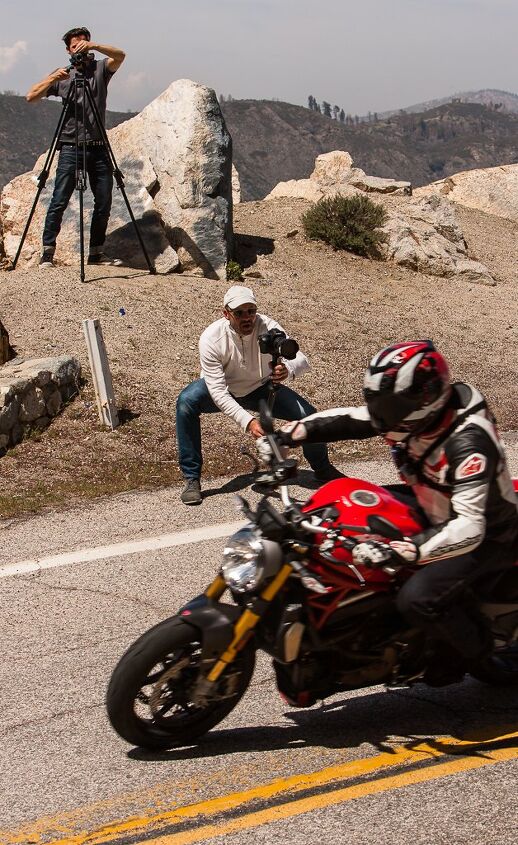 The standard Monster 1200 costs $13,495 compared to the S model at $15,995. The $2,500 price increase buys you a claimed 10 additional horsepower and 5.2 ft-lbs of torque. There’s also fully adjustable Ohlins suspenders, front (48mm stanchions) and rear on the S, vs a fully adjustable 43mm Kayaba fork, and Sachs monoshock with adjustable spring preload and rebound damping on the standard model. The standard Monster 1200 costs $13,495 compared to the S model at $15,995. The $2,500 price increase buys you a claimed 10 additional horsepower and 5.2 ft-lbs of torque. There’s also fully adjustable Ohlins suspenders, front (48mm stanchions) and rear on the S, vs a fully adjustable 43mm Kayaba fork, and Sachs monoshock with adjustable spring preload and rebound damping on the standard model.The Monster also deserves high-praise for its attention to passenger accommodations, an attribute the other OEMs seem to have forgotten about on their models.*“If you ride around with a passenger a lot, it’s almost the only choice here,” says Burns. “Shame on the others for barely paying any attention to passenger seating.” At 32.5 inches the Monster has more distance between bar-ends compared to BMW’s 31.5, Kawi’s 31.1 and KTM’s 31 inches. While this provides extra leverage for bending the bike with the longest wheelbase through tight arcs, Duke said the bend felt awkward to him. The Monster is the only bike here with an adjustable seat going from its 31.9-inch standard seat height to 30.9-inches by way of four easily removable plastic caps. It’s also the only bike with grab rails for a passenger and a seat cowl. So, if you’re looking for an awesome GT streetfighter, the Monster 1200S is in a class by itself. However, when thrown in a class of other streetfighters, such as the Super Duke R and S1000R, the Monster isn’t going to be everyone’s first choice. – Tom Roderick 2014 Super Naked Street Brawl + Video appeared first on Motorcycle.com. Click here for full story...
__________________________________________________
I'm a bot. I don't need no stinkin' signature... |
|
|

|
 |
 Similar Threads
Similar Threads
|
||||
| Thread | Thread Starter | Forum | Replies | Last Post |
| [motorcycle-usa.com] - Best Street Bike 2014: KTM 1290 Super Duke R | Ninjette Newsbot | Motorcycling News | 0 | December 30th, 2014 06:20 PM |
| [motorcycle.com] - 2014 Lightweight Naked Shootout + Video | Ninjette Newsbot | Motorcycling News | 0 | September 11th, 2014 08:50 PM |
| [motorcycle.com] - 2014 Yamaha Super Tenere ES Review + Video | Ninjette Newsbot | Motorcycling News | 0 | April 3rd, 2014 04:50 AM |
| [motorcycle.com] - 2014 Super-Middleweight Sportbike Shootout Video | Ninjette Newsbot | Motorcycling News | 0 | February 10th, 2014 06:00 PM |
| [motorcycle.com] - 2014 KTM 1290 Super Duke R Video Review | Ninjette Newsbot | Motorcycling News | 0 | November 15th, 2013 10:40 AM |
|
|